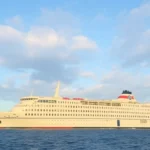Surprises Await You in Manila

When we arrived in Manila, our expectations were relatively low. This sprawling metropolis, one of the most densely populated cities in Asia, is often associated with poverty and crime. Yet, Manila once sparkled as the "stronghold of Asia," a title it held centuries ago. As we began our exploration, we wondered: could remnants of that vibrant city still exist amidst the chaos?
Our first encounters were daunting; on the metro to our hotel, a local warned us, "Be careful with the Filipinos, don’t trust anyone." Just minutes later, we faced our own scare when a ladyboy attempted to snatch Lety's backpack as we crossed a busy intersection. The feeling of insecurity crept over us, a sensation foreign to our travels over the past eight months. To add to our discomfort, our hotel was situated above a rather dubious bar. At least the bed was comfortable!
Seeking a respite from the hustle, we strolled along the waterfront and Rizal Park. Yet, the omnipresent jeepneys, always bustling with activity, reminded us of the city’s ceaseless motion. In the park, we paid our respects at the Rizal Monument, dedicated to the national hero who was executed by Spanish forces. His writings posed such a threat that one can only imagine how publications like El Jueves would fare in an environment like this.
To escape the street chaos, we turned to shopping malls, a familiar refuge. Surprisingly, we decided to catch a movie—Lety’s favorite director had just released a new film, and the local cinemas offered original-language screenings. After so long, it felt like a treat, even if we couldn’t indulge in our usual double feature as we did back in Barcelona.
However, the true highlight of our stay in Manila came with our visit to Intramuros, the historic walled city that stands as a testament to Spanish colonial architecture. Despite suffering extensive damage during World War II, many structures still evoke a sense of old-world charm reminiscent of Zamora. For a moment, it felt as if we had stepped back in time.
Intramuros is a different world, where chaos gives way to tranquility. Here, we found clean streets lined with Spanish-style buildings, cobbled pathways, quaint plazas, and beautiful churches. At the edge of the river, a formidable fortress loomed, and I could almost envision the serene views reminiscent of the Duero River back home.
Essential Information for Visiting Manila
How to Get to Manila
We arrived by plane from Puerto Princesa. To reach the Malate-Ermita area, we first took a bus from the airport to ESDA station, costing us around 20 PHP. Next, we hopped on the LRT (Light Rail Transit) from nearby, disembarking at Pedro Gil station for an additional 15 PHP. For our return to the airport, we opted for a taxi from Roxas Avenue, which was quicker and cost approximately 140 PHP, about a 20-minute ride.
Accommodations in Manila
This area offers various lodging options, albeit at higher prices. We opted for the Amazonia Hotel, located at 470 Santa Monica Street, which charged us 765 PHP per night for a room equipped with a fan, bathroom, Wi-Fi, and TV. Despite its above-bar location, it was relatively quiet, save for the occasional thumping of heels at 3 AM. While there are cheaper guesthouses nearby, they often come with significantly lower standards.
Exploring the Rich Culture of Manila
Beyond Intramuros, Manila presents a tapestry of culture and traditions. The city's identity is shaped by its complex history, which includes Spanish colonization, American influence, and indigenous heritage. This melting pot is reflected in its culinary offerings, arts, and lifestyle.
While wandering the city, we discovered vibrant street markets where the air was filled with tantalizing aromas. From adobo to sinigang, Filipino cuisine offers a delightful array of flavors, often accompanied by a warm smile from the vendors.
- Adobo: A savory dish made with meat marinated in vinegar, soy sauce, garlic, and spices.
- Sinigang: A sour soup typically made with tamarind, tomatoes, and various proteins.
- Pancit: Noodle dishes symbolizing longevity, often served during celebrations.
- Lumpia: Filipino spring rolls filled with vegetables or meat, perfect as a snack.
Safety and Travel Tips for Manila
As with any major city, being aware of your surroundings is crucial. Here are some safety tips to help you navigate Manila:
- Stay vigilant: Keep personal belongings secure and be cautious of pickpockets.
- Use reputable transportation: Opt for registered taxis or rideshare apps rather than unlicensed cabs.
- Travel in groups: If possible, explore the city with fellow travelers or locals.
- Research areas: Familiarize yourself with neighborhoods to avoid less safe regions.
Unforgettable Experiences Await in Manila
Despite initial impressions, Manila is filled with unexpected delights. From the historical enclaves of Intramuros to the lively street markets and diverse culinary scene, the city continually surprises. For those willing to explore beyond the surface, Manila promises a wealth of experiences.
To get a glimpse of the vibrant life in Manila and the surprises it holds, check out this video showcasing some lively moments in the city:
With each passing day, we realized that Manila is not just a stopover but a destination rich in stories, culture, and resilience. As we departed, the city lingered in our minds, a reminder that often, the most remarkable experiences come from the places we least expect.






Deja una respuesta